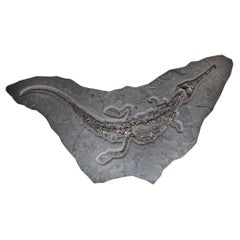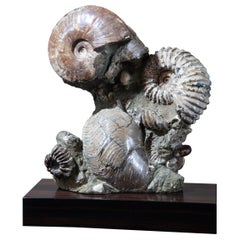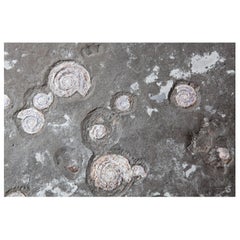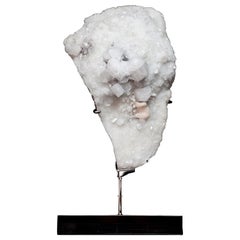Want more images or videos?
Request additional images or videos from the seller
1 of 6
Fossil Scallop Shell Bed from France, 20 Million Years Old
$18,220.69List Price
About the Item
- Dimensions:Height: 33.86 in (86 cm)Width: 31.5 in (80 cm)Length: 33.86 in (86 cm)
- Materials and Techniques:
- Place of Origin:
- Period:
- Date of Manufacture:Unknown
- Condition:
- Seller Location:London, GB
- Reference Number:1stDibs: LU994316755141
About the Seller
5.0
Vetted Professional Seller
Every seller passes strict standards for authenticity and reliability
1stDibs seller since 2013
10 sales on 1stDibs
Authenticity Guarantee
In the unlikely event there’s an issue with an item’s authenticity, contact us within 1 year for a full refund. DetailsMoney-Back Guarantee
If your item is not as described, is damaged in transit, or does not arrive, contact us within 7 days for a full refund. Details24-Hour Cancellation
You have a 24-hour grace period in which to reconsider your purchase, with no questions asked.Vetted Professional Sellers
Our world-class sellers must adhere to strict standards for service and quality, maintaining the integrity of our listings.Price-Match Guarantee
If you find that a seller listed the same item for a lower price elsewhere, we’ll match it.Trusted Global Delivery
Our best-in-class carrier network provides specialized shipping options worldwide, including custom delivery.You May Also Like
Group of fossil shell scallops, France, Burdigalien era, -20millions Years
Located in MARSEILLE, FR
This unique fossil piece of scallops (also called Saint Jacques shells, or scientifically : gigantopecten restitutensis) is from around 20 millions years ago. It was found in the sou...
Category
2010s French Natural Specimens
Materials
Stone, Limestone
$3,451
H 16.54 in W 18.51 in D 8.67 in
10.75" Polished Ammonite Shell Fossil Cleoniceras Species, Agatized
Located in Warrenton, OR
10.75" Polished Ammonite Shell Fossil Cleoniceras Species, Agatized, Over 100 Million Years Old. A truly spectacular ammonite in both size and appearance. Weighing almost 8 pounds, w...
Category
Antique 15th Century and Earlier European Organic Modern Natural Specimens
Materials
Shell, Organic Material
Dryosaurus Altus Dinosaur Femur Fossil // 150 Million Years Old
Located in New York, NY
This is the well preserved and fully intact fossilized femur of a Dryosaurus altus, found in Emery County, Utah within the famous fossil-rich Morrison Formation spanning much of the ...
Category
Antique 15th Century and Earlier American Natural Specimens
Materials
Other
$1,050 Sale Price
30% Off
H 1.75 in W 7.5 in D 1.5 in
Conlinoceras Tarrantense Ammonite Fossil, 90-100 Million Years Old
Located in Warrenton, OR
Conlinoceras Tarrantense Ammonite Fossil, 90-100 Million Years Old.
The Conlinoceras Tarrantense Ammonite is considered rare and is highly sought after as a collector's item.
Thi...
Category
Antique 15th Century and Earlier American Organic Modern Natural Specimens
Materials
Shell, Organic Material
Conlinoceras Tarrantense Ammonite Fossil, 90 to 100 Million Years Old
Located in Warrenton, OR
Conlinoceras Tarrantense Ammonite Fossil, 90 to 100 Million Years Old. A rare and highly sought after ammonite for collectors. The ammonite itself is somewhere between 5 and 6 inch...
Category
Antique 15th Century and Earlier American Organic Modern Natural Specimens
Materials
Shell, Organic Material
Natural Ammonite Fossil Specimen Mortoniceras Drakeoceras 110 Million Years Old
Located in Warrenton, OR
Natural Ammonite Fossil Specimen Mortoniceras Drakeoceras 110 Million Years Old apx.
We love the elegance of this ammonite specimen and are excited to be able to present it here. Th...
Category
Antique 15th Century and Earlier American Organic Modern Natural Specimens
Materials
Shell, Organic Material
$1,500
H 5 in W 6.5 in D 2 in
A Stunning Knobby Ammonite Fossil Specimen, About 93 Million Years Old
Located in Warrenton, OR
A Stunning Knobby Ammonite Fossil Specimen, About 93 Million Years Old.
This is a very beautiful, multicolored (to our eye, taupe-brown, peach, white, tan) ammonite with leafy patter...
Category
Antique 15th Century and Earlier American Organic Modern Natural Specimens
Materials
Shell, Organic Material
Polished Ammonite Fossil, Cleoniceras sp, Around 110 Million Years Old
Located in Warrenton, OR
Polished Ammonite Fossil, Cleoniceras sp, Around 110 Million Years Old, with Beautiful Leafy-Like Suture Patterns.
This piece will need a stand for you to display it upright unless y...
Category
Antique 15th Century and Earlier Unknown Organic Modern Natural Specimens
Materials
Shell, Organic Material
$600
H 4.5 in W 3.5 in D 1.25 in
Alethopteris Species Fern Fossil Natural Specimen, 305+ Million Years Old
Located in Warrenton, OR
Alethopteris Species Fern Fossil Natural Specimen, 305+ Million Years Old. This is such a stunning piece that it simply must have a stand. If you like, this stand will be included a...
Category
Antique 15th Century and Earlier American Organic Modern Natural Specimens
Materials
Organic Material
$390
H 5.5 in W 8 in D 1.25 in
Mariopteris Species Natural Tree Fern Fossil Specimen, 300+ Million Years Old
Located in Warrenton, OR
Mariopteris Species Natural Tree Fern Fossil Specimen, 300+ Million Years Old
Discovered in Pennsylvania. Hues occur naturally over time through the mineralization process. The hues ...
Category
Antique 15th Century and Earlier American Organic Modern Natural Specimens
Materials
Organic Material
$340
H 5 in W 5 in D 0.75 in
More From This Seller
View AllGiant Crocodile Fossil Wall Plate, Germany. 180 Million Years Old.
Located in London, GB
This outstanding fossilised skeleton is that of the ancestral crocodile species Steneosaurus bollensis that lived during the early Jurassic period. The skeleton, complete with armoured plates, has been exquisitely preserved and recovered from the Holzmaden Oil Shale of south Germany.
The crocodile was once buried in fine, muddy sediment 195 million years ago at the bottom of the Tethys Ocean, which once existed between Europe and Africa. The calm, deep water provided a rare anoxic (without oxygen) environment, which prevented the skeleton from any significant decomposition before burial. The mud has since been compressed into oil shale, leaving the immense skeleton completely in-tact.
This specimen is one of the few skeletons of Steneosaurus bollensis ever to be discovered. We can deduce much about the life of this reptile from the size and perfect preservation of the piece. Similar to present-day crocodiles, we can see that the two front limbs of the Steneosaurus are much shorter than the back two. This indicates that crocodile ancestors were bipedal; indeed, we believe that crocodiles evolved from the same reptile species as the dinosaurs and airborne pterosaurs.
Dinosaurs ruled the lands during the late Triassic and early Jurassic. This made terrestrial life increasingly difficult for ancestral crocodiles, as there were many predators and prey was scarce. However, the seas were rich in fish, shellfish, starfish, crabs, squid… You can even see fossil belemnite guards (bullet shells of squid-like organisms) and the beautiful spiral shells of ammonites preserved around the crocodile skeleton...
Category
Antique 15th Century and Earlier German Decorative Art
Materials
Other
Rare Fossil Ammonite Cluster from Madagascar
By Dale Rogers Ammonite
Located in London, GB
Ammonites
High-quality ammonite fossils are prized by collectors and paleontologists alike for their intricate beauty and significant scientific value. Ammonites, cephalopods closel...
Category
Antique 15th Century and Earlier Malagasy Natural Specimens
Materials
Stone
United Kingdom Ammonite Fossil Plate
Located in London, GB
United Kingdom Ammonite plate.
Category
Antique 15th Century and Earlier British Wall-mounted Sculptures
Materials
Other
Giant Apophylite Crystal from India
Located in London, GB
Apophyllite crystals of this scale are rarely seen. This piece has been beautifully mounted onto a mirrored steel base making it the perfect statement for any interior.
Since 1986 D...
Category
Antique 15th Century and Earlier Indian Natural Specimens
Materials
Other
Giant Ammonite Cluster from Madagascar
By Dale Rogers Ammonite
Located in London, GB
Rare ammonites from Madagascar are highly sought after by collectors and paleontologists due to their exceptional preservation and unique features. These...
Category
Antique 15th Century and Earlier Malagasy Natural Specimens
Materials
Stone
Rare Yellow Fluorite Cube Formation from China
Located in London, GB
Large rare cubed yellow fluorite formation from China mounted on a mirrored steel base.
Since 1986 Dale Rogers has been sourcing the grandest fossils, crystals and minerals from a...
Category
Antique 15th Century and Earlier Chinese Natural Specimens
Materials
Other
Recently Viewed
View AllMore Ways To Browse
Sculptured Bed
Shell Bed
Fossil Scallops
Scalloped Bed
Large Quartz Specimen
Antique Fossils
Black Crystal Sculpture
Amethyst Brown
Rare Specimen
Polished Agates
Geode Rock
Green Malachite Furniture
Heals Antique Furniture
Crystal Geode
Rock And Minerals
Large Amethyst Sculpture
Natural Specimen Wood Sculpture
Aquamarine Furniture



